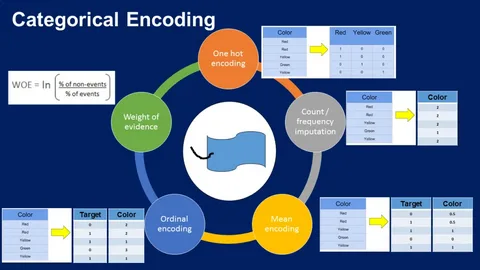Introduction
In the realm of data science, not all data is numerical. Categorical data—data that represents discrete categories or labels—is prevalent in real-world datasets, ranging from customer demographics to product types and survey responses. Unlike numerical variables, categorical data cannot be used directly in most machine learning algorithms. Therefore, handling and encoding categorical variables is a crucial step in the data preparation process.
For students pursuing a Data Science Course in Bangalore, understanding categorical data is fundamental. Proper encoding ensures models interpret the data correctly, avoids bias, and improves predictive performance. This article explores the types of categorical data, methods to encode them, and practical tips for effective handling in data science projects.
Understanding Categorical Data
Categorical data can be broadly divided into two types:
- Nominal Data: These are categories without any intrinsic order. Examples include colour, product type, or country of origin. The key characteristic is that one category is not greater or smaller than another.
- Ordinal Data: These categories have a defined order, though the difference between categories may not be uniform. Examples include education level (high school, undergraduate, postgraduate) or customer satisfaction ratings (low, medium, high).
Recognising the type of categorical data is essential because encoding strategies differ based on whether the data is nominal or ordinal.
Challenges with Categorical Data
Handling categorical variables presents several challenges:
- Non-Numeric Nature: Most machine learning algorithms require numeric input, so categorical variables must be transformed.
- High Cardinality: Some categorical features, like customer IDs or product SKUs, can have thousands of unique values, making encoding computationally intensive.
- Sparsity: One-hot encoding can create sparse matrices with many zero values, leading to increased memory usage.
- Risk of Misinterpretation: Incorrect encoding can introduce false relationships, particularly if ordinal assumptions are applied to nominal data.
Understanding these challenges allows data scientists to choose the most appropriate encoding method and avoid pitfalls during model building.
Common Techniques for Encoding Categorical Variables
Several encoding methods are widely used in data science:
1. One-Hot Encoding
One-hot encoding transforms each category into a binary column (0 or 1), representing the presence or absence of that category.
- Pros: Effective for nominal variables, prevents the model from assuming any ordinal relationship.
- Cons: Can create high-dimensional datasets with many categories, increasing computational load.
2. Label Encoding
Label encoding assigns a unique integer to every category.
- Pros: Simple and memory-efficient.
- Cons: May introduce unintended ordinal relationships, so it is best suited for ordinal data rather than nominal data.
3. Binary Encoding
Binary encoding combines the advantages of label encoding and one-hot encoding by converting categories into binary numbers, reducing dimensionality compared to one-hot encoding.
- Pros: Reduces the number of columns while preserving uniqueness.
- Cons: Slightly more complex to implement and interpret.
4. Frequency or Count Encoding
Categories are replaced with their frequency or count in the dataset.
- Pros: Captures the importance of a category based on its occurrence, works well with high-cardinality features.
- Cons: May not capture relationships between features and target variables directly.
5. Target Encoding
Each category is replaced with a statistic (like the mean) of the target variable.
- Pros: Incorporates predictive information from the target variable, useful for regression and classification tasks.
- Cons: Risk of overfitting if not carefully validated, particularly in small datasets.
Best Practices for Handling Categorical Data
To effectively manage categorical variables in data science projects, consider the following practices:
- Understand the Data: Identify whether variables are nominal or ordinal before encoding.
- Avoid High Cardinality Issues: Group rare categories into an “Other” category to reduce dimensionality.
- Prevent Data Leakage: Apply target encoding using cross-validation to avoid leaking information from the target variable.
- Use Sparse Representations: For large datasets, sparse matrices reduce memory usage and speed up computations.
- Combine Features Thoughtfully: Feature interactions, like combining city and product category, can uncover additional insights.
Real-World Applications
Proper handling of categorical data has wide-ranging applications:
- Retail Analytics: Encoding product categories and customer demographics to predict purchase behaviour.
- Healthcare: Transforming diagnostic categories and treatment types for predictive models in patient outcomes.
- Finance: Handling categorical variables such as transaction types or credit ratings in risk models.
- Marketing: Analysing survey responses or engagement metrics to personalise campaigns.
These examples show that categorical data, when correctly processed, drives meaningful insights across domains.
Tools and Techniques
Students in a Data Science Course in Bangalore typically use several tools to manage categorical data:
- Python Libraries: Pandas for preprocessing, Scikit-learn for encoding techniques
- Visualisation Tools: Bar plots, count plots, and heatmaps to understand distribution and relationships
- Automated Preprocessing: Feature-engine or category_encoders libraries for efficient transformations
Hands-on experience with these tools ensures learners can implement encoding strategies effectively in real-world projects.
Conclusion
Categorical data is ubiquitous in real-world datasets, yet its improper handling can compromise model accuracy and insights. Understanding the types of categorical variables, the challenges they pose, and the available encoding techniques is essential for every aspiring data scientist.
For students enrolled in a data science course in Bangalore, mastering categorical data handling provides a solid foundation for feature engineering and model building, enabling them to create more accurate, interpretable, and impactful predictive models.
By implementing best practices, selecting the right encoding strategy, and leveraging modern tools, data scientists can unlock the full potential of categorical data, transforming discrete labels into actionable insights.
In conclusion, categorical data is not just another variable type—it is a strategic asset that, when handled effectively, enhances the power and precision of data-driven decisions.


